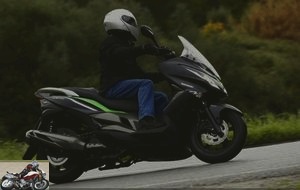Menus
- Ninja and Z inspiration for the 1st Kawasaki maxi-scooter
- Discovery
- In the saddle
- Contact
- In the city
- On the highway
- Departmental
- Duo
- Convenient
- Consumption
- Conclusion
- Interview
- Meeting with Mr Tsuyoshi Shibata, Kawasaki Product Planning Director
- Le Repaire: How was the idea of launching a scooter born? ?
- Why a solution based on Kymco ?
- Why a 300cm3 ?
- Other scooters to come, maybe 100% Kawasaki this time or another model based on Kymco and less motorcycles ?
Ninja and Z inspiration for the 1st Kawasaki maxi-scooter
Kawasaki was the last of the Japanese manufacturers not to have scooters in its range and it is therefore no surprise that the Akashi company unveiled its first maxi-scooter with the J300 at the Eicma 2013 show..
The first scooter in a larger series to believe the brand that works on urban mobility solutions (concept J …), the manufacturer here relied on Kymco (like BMW with the C600 and C650GT) to offer this medium displacement model. However, the J300 does not stand out in the green range and is inspired by the design of the Ninja and Z with its angular fairing, dual front headlights and LED taillight. So, just a rebadged Kymco or a real Kawasaki scooter justifying its purchase in its own right? Truth test…
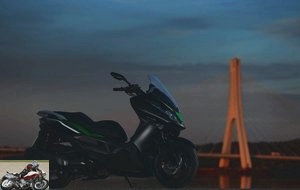
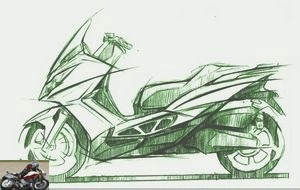

Discovery
The J300 imposes by its size closer to a 500 than a 300cm3. If it weren’t for the number engraved on the side, it would even be quite wrong. Front face in the look of Z750, rather Ninja profile, wide two-seater saddle, massive stern are very encompassing and plush, affirming a desire to appear bigger. Suddenly, in this beefy aspect, the lines stretched as if with billhooks from the front contrast with a template closer to a GT scooter. The end result is homogeneous, with an exterior Kawasaki identity, especially between the front optics and the rear light. The brand is displayed twice and in full on the fairing and in relief. However, we will find on the identification plate of the scooter, placed under the scooter and the central stand, the inscription Kwang Yang Motor Co.
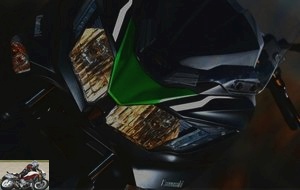
On the engine side, we therefore find the liquid-cooled single-cylinder engine of 299 cm3 fitted to the Dinkstreet, equipped with an automatic transmission and delivering a maximum power of 28 horsepower for a torque of 28.7 Nm. Side cycle, the front suspension is ensured by a 37 mm telescopic fork while two adjustable shock absorbers Kawasaki sauce equip the rear. Braking, ABS, is provided by two petal brake discs and double piston calipers.
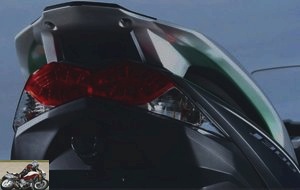
In terms of the small details that make the difference on a daily basis, we note the adjustment of the spacing of the brake handles, the contactor shutter (usual at Kymco), the glove box (without key) incorporating a 12-volt socket for the accessories or the notch at the level of the steps making it easier to put your feet on the ground when stationary.
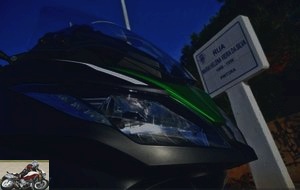
In the saddle
The scooter gets up well from its side stand but again, we have the impression of dealing with a larger template. The 191 full kilos are there. The 1.70 pilot only puts his feet on the ground but on a daily basis, it is easily handled. The saddle immediately offers a pleasant felt comfort, closer to a gel saddle, than the firmness impressions of certain scooter saddles, even with larger displacement.

Under the eyes, we find a Kymco environment, at the handlebar level (overall shape, position) even if the Kawasaki logo is clearly displayed in the center of the handlebars and inside the meter. Plastic of the dashboard, storage compartment closure, adjustment of the Trip reset buttons or the passage from miles to kilometers are also pure Kymco and deserve a higher quality hair, more than the usual Kawasaki standard. However, the analog speedometer and tachometer are clear and easy to read, as is the digital display in the center with the five-stick fuel gauge. The mirrors are easily adjusted and provide good side and rear vision. The overall position is natural and comfortable and we find our place, the arms being noticeably raised but the knees well horizontal. Even the older ones will be well there.

Contact
The J300 snorts with a sound more advanced than usual far from the muffled sounds of some scooters, pledge of a little character. The solicitation of the right grip finds an immediate response to the acceleration level, propelling the scooter dynamically. This dynamic is immediate and not only sound, with a rev counter immediately climbing to 7,000 rpm and a speed already prohibited in town.

In the city
Very dynamic at a standing start at a red light, the J300 then slides easily into traffic, with excellent pick-ups, whatever the engine speed. Braking and successive acceleration follow one another with ease and dynamics. Braking is good and ABS (by default on all models in France) very little intrusive. You really have to be in the rain and push hard to make it go off. In any case, only the ABS model being imported into France, the user will have no other option..
After testing cobblestones and streets with disparate surfaces, the J300 absorbs all the differences with impressive smoothness and consistency. Far from certain models of scooters as hard as pieces of wood, there is here a real comfort which makes even the climbs and descents of sidewalks easy and pleasant and in any case quite soft for the lumbar !
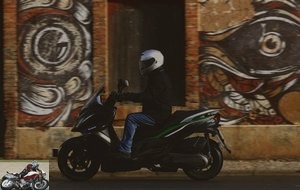
On the highway
The J300 quickly sets off on the motorway. We would rather readily expect to see it stagnate from 130 km / h, like many scooters in the category. But the counter continues to climb to reach 140 km / h at 8,000 rpm and then continues its momentum up to 160 km / h and 9,000 rpm, without flinching. Even if the speedometer is a little pretentious in the order of 10-12 km / h (GPS measurement), some models with larger displacement do not do better. And in any case, for a model more intended for urban and peri-urban, the J300 shows that it is capable of doing much better. And again, the model was barely broken in. Enough to suggest the possibilities of weekends by the sea, in duo, in all serenity and at speeds in any case prohibited on the French motorway. And yet, even at maximum speed, the stability of the J300 is excellent in a straight line, giving confidence. And despite the absence of a high bubble, the air is well deflected, causing no disturbance or pronounced pressure on the helmet..
Departmental
The J300 arrives on departmental roads with as much ease as on other terrains. Able to wind quietly on mountain roads, it is just starting to show its limits when the pace picks up. We then begin to feel the frame working and if it rains the tires sketch the beginnings of sliding. This is never worrying, especially since the J300 does everything smoothly and warns as you go, in these extreme conditions that 99% of users will never experience.

Duo
The passenger has two retractable footrests. The spacious saddle contributes to the comfort for both rider and passenger. The overall power also allows not to feel the excess weight too much and therefore to consider the duo road well beyond city trips.
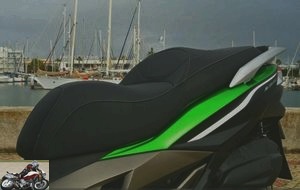
Convenient
The boot opens under the saddle from the main switch. The interior light illuminates very well and allows you to better see or store your full face helmet plus an A4 size computer, or even a small jet or rain pants in addition. It is not the largest storage capacity in the category (it is possible to find cases that accept two full face helmets) but some larger displacement scooters have less capacity as well. It is therefore an excellent compromise.
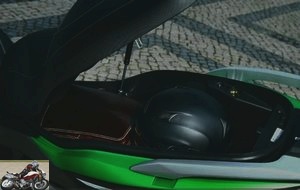
The front storage compartment is small but deep, capable of carrying a few papers, a bunch of keys at most. On the other hand, it benefits from a cigarette lighter socket which can therefore be used to recharge a mobile phone. So deep, it accepts a large Samsung Galaxy-type smartphone. On the other hand, the horizontal position of the socket prevents catching what is then at the bottom of the storage compartment..

With both a side stand and a central stand, the J300 parks without any problem, especially since the center stand is particularly easy to position. We just regret the lack of parking brake, prohibiting parking on a slope or slope.
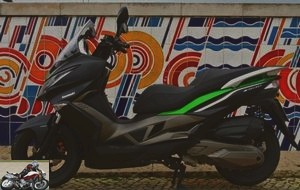
Consumption
The first bar of the fuel gauge only drops from 120 km, then regularly at a rate of about one bar every 40 km. A longer test should demonstrate the same range as the Kymco model, nearly 300km, with an average consumption of 4.2 liters per hundred for the 12.5-liter tank..
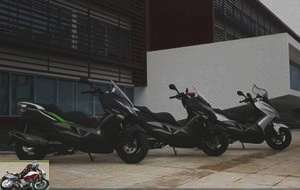
Conclusion
As comfortable in town as outside the town with even the inclination of long roads, the J300 appears as a real surprise in terms of versatility, going beyond the expectations that we have of a 300 cm3. Kawasaki has also been able to add the green touch to overcome the main flaws of the Kymco base in terms of look and especially comfort, with here a really pleasant and comfortable model for everyday use. The most picky will eventually regret some finishing details which would then have put it at the best level of the category, all brands combined. Suddenly, despite a higher price of 500 euros compared to the original model (5,099 euros with ABS, 5,249 euros in SE ABS version), the price difference is justified here, not to mention even the pleasure of officially driving a green machine. It only remains to choose the color! Rather green and black in SE edition, or more traditional in gray or black ?
Strong points
- Motor
- Max speed.
- Comfort
- Braking and ABS
- Quality / price ratio
- Look
Weak points
- Finishing of some details
- No parking brake
- Tires
 Interview
Interview
Meeting with Mr Tsuyoshi Shibata, Kawasaki Product Planning Director
Le Repaire: How was the idea of launching a scooter born? ?
Mr. Tsuyoshi Shibata: Kawasaki is working on urban mobility solutions in the broad sense, as the J concept proves. The scooter is one of these solutions and there will be others in the years to come, even if nothing is further formalized by a specific product.
Why a solution based on Kymco ?
Mr. Tsuyoshi Shibata: Kawasaki is a motorcycle manufacturer with no scooter experience. Rather than taking the risk of creating a 100% product, it was more reasonable to rely on a brand that had experience in this area while bringing some Kawasaki elements to deliver an exciting product, like the other models of our brand.
Why a 300cm3 ?
Mr. Tsuyoshi Shibata: The 300cm3 is a good balance between small displacement and large displacement maxi-scooters. We also analyzed Kymco products in terms of experience, reliability and customer feedback. Their 300cc was the model that most met the reliability and quality criteria we wanted..
Other scooters to come, maybe 100% Kawasaki this time or another model based on Kymco and less motorcycles ?
Mr. Tsuyoshi Shibata: Kawasaki will continue to develop motorcycles as before. We have not yet decided if there will be another scooter. But if there is one, it won’t be a 100% Kawasaki scooter. As for our partnership with Kymco, it only concerns this model. There will be other urban mobility solutions – not just in concept – but nothing is fixed yet on the solution (s) to come..
Datasheet
Related articles
-
Piaggio MP3 500 LT ie scooter test
MP3 … Piaggio never stops offering its flagship three-wheeler in all possible displacements and variations, business included. In the LT version (Large…
-
2007 Kawasaki Z1000 motorcycle test
Five-day test of the 2007 vintage roadster The Kawasaki Z1000 released in 2003 was well received but mixed: a look of hell but an engine considered like…
-
2009 Kawasaki ER-6n motorcycle test
3-day twin-cylinder roadster test The Kawasaki ER6n is Akashi’s twin-cylinder roadster initially introduced in 2005, which has achieved unprecedented…
-
Peugeot Satelis 125i scooter test
Urban GT scooter If Peugeot is not the benchmark in terms of maxi-scooter, the Satelis 125 is on the other hand a benchmark in the world of the 125 cm3…
-
Test scooter BMW C600Sport vs C650GT
Between Zyva and Bobo One would have thought that after the success of the C1, the brand’s first foray into the scooter segment, BMW would have buried…
-
GO! S1.4, GO! S2.4 and GO! S3.4 scooters comparison Electricity is everywhere! In development for several years now, electric vehicles are multiplying…
-
Vespa Elettrica electric scooter test
Equivalent boosted wasp 125 100 km of range, 4 hours of full charge, 4 kW, 200 Nm of torque I love Vespas! The test started badly! Could I be objective!…
-
NIU M-Series: Sport or Pro Electricity is on the rise, if only to circulate freely in city centers which increasingly prohibit access to thermal energy….
-
Vespa GTS 300 HPE scooter test
History of Grand Tourism Single cylinder, 23.8 hp, 26 Nm of torque, ABS, ASR traction control As soon as we speak of Vespa, we imagine the Dolce Vita and…
-
Urban GT scooter Hexagon, X8, X9…. Piaggio has come a long way since 1993, posting more than 400.00 cumulative sales for the brand, which is the segment…
